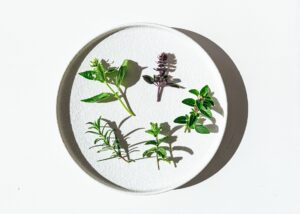The digestive process begins with the movements of the sun, the earth, and other celestial bodies that provide the power and light so that our food can grow and be filled with QI or life energy. Careful cultivation, harvest, storage, traditional processing and cooking also influence the energy and nutritional value of the food, make it easier to digest and intensify the positive effect.
Chew and digest
Chewing activates enzymes in the mouth and stimulates saliva production, which is the prerequisite for the food to be processed well by the other digestive organs. In the small intestine, the food components are finally absorbed into the body and transported to the blood and other vessels, where they nourish the mind, body and soul.
The digestive enzymes and salivary juices activated by chewing include:
- Ptyalin (amylase). Ptyalin is a clear, aqueous enzyme solution that is produced by the parotid glands, which are located just below the ears. Ptyalin (also known as amylase) makes food more basic. This base formation counteracts acidification and activates and energizes the food. Persistent chewing creates a surge of energy or a connection between the tongue and the uvula (also called the uvula, the small process in the middle of the palate). This has an alkaline-forming, mineralizing or slightly electrifying effect and strengthens the Qi or the life energy that is absorbed from food and nutrients and other substances. Most importantly, ptyalin helps digest complex carbohydrates, especially whole grain foods.
- Slimy (mucous) saliva is produced by the sublingual salivary glands under the tongue. This thick, sticky substance holds the food items together (called a bolus or chyme after the chyme has reached the stomach) and makes it easier for them to slide down the esophagus and into the digestive tract.
- Both ptyalin and slimy saliva are supplied by the submandibular gland, which is located close to the lower jaw. These digestive juices come from ducts under the tongue.
- Parotin, another enzyme produced by the parotid gland, activates cellular metabolism and helps tissues and organs to regenerate.
- Lipase, the enzyme that breaks down fat, is also stimulated by chewing. Lipase from the bile is later transported to the liver and secreted in the duodenum to complete the digestion of fat and oil.
- If you eat too many high-protein foods, the amount of ptyalin in your mouth will decrease. Protein is metabolized by hydrochloric acid and pepsin in the stomach and by enzymes from the pancreas and small intestine in the duodenum. Too much animal food, especially dairy products (dairy products come from the animals’ glands) prevent these substances from being released.
- Saliva contains hydrogen carbonate (highly basic), which activates cellulase, the enzyme in raw vegetables and fruits that breaks down cellulose or fiber. Chewing is essential for the breakdown of cellulose. Hydrogen carbonate also neutralizes excess acids or basic components in food and beverages.
- Sufficient chewing envelops the food with the enzyme-rich saliva, which protects against harmful viruses, bacteria or other microorganisms, as well as against chemicals, radiation and other toxins in the food.
Chewing and the circulatory system. Chewing stimulates blood flow and the circulatory system, especially through the movements of the jaw. Chewing brings more blood to the muscles and distributes it throughout the body. In addition, the blood becomes more basic and is strengthened.
Chewing and the endocrine system
The endocrine system is activated directly by the enzyme ptyalin. It stimulates the tonsils so that the thymus secretes special cells called T lymphocytes. These cells protect the body from cancer and immune deficiency. The hypothalamus and the pituitary gland in the center of the head are also stimulated and activated by the spiraling movements of chewing. Chewing helps neutralize toxins. Out of necessity (hunger), when traveling, or in company (for example at a birthday or family party) we may sometimes eat foods that we otherwise avoid, such as sugar, dairy products, or genetically modified foods. In this case, chewing can help lessen its harmful impact. There are stories of accident survivors, prisoners of war, or other people in extreme situations who, by chewing enough, were able to neutralize poisonous berries, herbs, or other foods, even contaminated water.
The healing power of saliva
Saliva is one of the oldest and most powerful remedies. Injured or wounded animals instinctively lick the painful area. People, too, immediately stick their fingers in their mouths after slapping their thumbs or cutting their fingers and covering it with saliva. The saliva of dogs has a disinfectant effect. When a dog licks a wound, it heals faster. In ancient China, saliva was widely used for healing and life extension, especially by the Taoists. Some texts instruct you to swallow your own saliva in order to accelerate physical healing. Saliva, along with other liquids and essences, was used by the Chinese as a potent cure for sexual disorders, and was considered the golden elixir for extending life and expanding consciousness.
In the Bible, Jesus also used a traditional healing method when he used his own saliva for healing. Once he took a deaf man aside and put his finger on his ear, then put saliva on his finger and touched the man’s tongue with it (Mark 7:33). At another time he spat on the ground, mixed clay with saliva, and rubbed it on the eyes of a blind man (John 9: 1-7). After washing in a pond, the man could see.
How much faith in the healing power of Jesus – with a placebo effect – is involved remains open.
Chew and the meridians
The meridians or channels of natural energy supply the chakras with AI and distribute this QI via meridians in every tissue and every cell of the human body. The meridians associated with chewing are the stomach, liver, small intestine, triple heater, bile and bladder meridians. Then there are the conducting and draining vessels that stimulate the entire organism. In addition, each tooth corresponds to a meridian. And each tooth in turn corresponds to a vertebra. The molars, which chew grains and other complex and carbohydrate-rich foods, are connected to the meridians of the lungs, heart, and colon. The incisors that chew vegetables and other vegetable foods are connected to the kidney meridian. Finally, the canines, which tear apart animal food, are connected to the liver.
Chew and the chakras
Chakra (from Sanskrit: wheel) are vertically arranged energy centers which, together with the meridians, form the energetic structure of the human being. Chewing stimulates and activates the central energy channel, which runs from the crown chakra through the third eye (the pineal gland or pituitary gland) to the throat, heart, solar plexus, sacral chakra (also called hara) and root chakra.
The spiral of energy that runs inward from heaven stimulates the uvula, while the spiral of energy that runs outward from the earth stimulates the tongue.
These two spirals meet at the place where food is chewed, thus closing the cycle and creating a flow of electromagnetic energy that energizes the entire organism. The sixth and fifth chakras are the ones that most support chewing. The pineal chakra, closest to the parotid glands that produce ptyalin, supports and orders sensory perception and controls higher consciousness. The production of saliva in the lower part of the mouth and the movements of the jaw are particularly stimulated by the throat chakra and influence language, creativity and self-development. When we chew very thoroughly – 100 to 200 times per bite – the grains become alkaline due to the combination with the alkaline salivary enzyme ptyalin, and then they create an acidity, even if you only eat grains. A pinch of sea salt should still be used for cooking. Sea salt is base-forming.
Saliva is the secretion from the salivary glands. This body fluid is produced by the human organism (and not by the pharmaceutical industry. The saliva production glands are located in the oral cavity and also in certain internal organs such as the pancreas. As a result, for example, mouth saliva and pancreas are different.
The saliva contains an average of 0.5 percent solid components. The following should be emphasized: Mucin (a polysaccharide) various proteins and a digestive enzyme (dynastic ferment), alpha-amylase (ptyalin), which breaks down the starch (polysaccharide) contained in food.
The pH value is between 5.5 and 6 with resting secretion; after stimulation by chewing movements it increases to around 7.6 to 7.8. Alkaline. The average saliva production is 1 to 1.5 liters per day. So not to be underestimated for the metabolism. Ptyalin, also called salivary amylase. Ptyalin is the alpha-amylase of the saliva and breaks down starch into disaccharides (double sugars) such as maltose or dextrose.
Now you can better understand why liquid food, for example in the form of smoothies, is not recommended as a main food. Smoothies have their place, but don’t forget the importance of chewing them.
Do not forget: Well chewed is half digested.
Note:
QI does not consist of electromagnetic energy, but of scalar waves. Scalar waves is just another name for the QI, unknown in the west. QI or Chi is pure energy.







